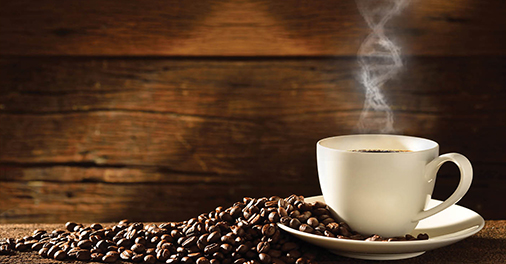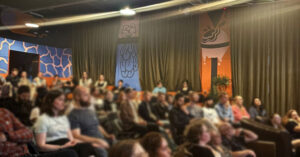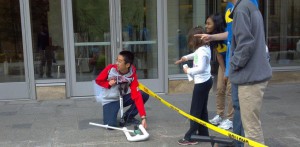There is no shortage of stories about great scientific collaborations that have taken root as the result of an excited conversation between two scientists over sandwiches and beer at a bar or a deli. One of the most famous examples of such a conversation was that between Herbert Boyer and Stanley Cohen when they attended a conference on bacterial plasmids in 1972—that very conversation led to the formation of the biotechnology field as the two scientists worked together to clone specific regions of DNA (1).
“Over hot pastrami and corned beef sandwiches, Herbert Boyer and Stanley Cohen opened the door to genetic engineering and laid the foundations for gene therapy and the biotechnology industry.”
Steven Johnson, author of Where Do Good Ideas Come From, credits the English coffee house as being crucial to the spread of the enlightenment movement in the 17th and 18th centuries (2). He argues that coffee houses provide a space where ideas can come together and form networks. In fact, he defines the concept of “idea” not as a single entity—a grand thought that poofs into existence upon hard work—but at its simplest level, a new idea is a new network of neurons firing in sync with each other.
Johnson further argues that the development of great new ideas not only requires a space for ideas to bump into each other, connect and form a network, but also that great ideas are rarely the product of a single “Eureka” moment. Rather, they are slowly developing, churning hunches that have very long incubation periods (2).
Science is Ripe with “Coffee House” Discoveries

The Age of Enlightenment and the Scientific Revolution in Europe occurred during the 17th and 18th centuries and were characterized by ideas that celebrated the value of learning through rational thought and scientifically rigorous experiments. During the Age of Enlightenment and the Scientific Revolution, scientists were members of highly active local societies, and they presented their work in person, discussing their research observations and experimental conundrums at length either in the meetings or through personal correspondence. Indeed these early societies (e.g., The Lunar Society of Birmingham) and the practice of presenting work to a body of people for “crowdsourcing” ideas and commentary are the predecessors of the scientific conferences that researchers attend today (e.g., American Society for Cell Biology Cell Bio Meetings or The European Society of Human Genetics). These meetings bring researchers from across the globe together to learn about the latest work and discuss experimental roadblocks, questions and challenges. As well, many smaller communities of scientists that specialize in a specific system or technology can be found actively collaborating at more specialized conferences. For instance the C. elegans meetings (worm meetings) provide opportunities for researchers around the world working on the C. elegans model system to compare notes. These scientists may be working on distinct biological questions, but they are all using the same system—providing opportunities for electrophysiologists studying topics like muscle contraction to connect with developmental biologists studying topics like cell specialization. Drosophila and Arabidopsis researchers have similar communities.
From the Boyer and Cohen example described above to the many casual conversations detailed in Watson’s The Double Helix (albeit some of them quite controversial) to conversations in breakrooms, hallways and happy hours at scientific conferences today, casual conversations have led to many stunning collaborations and breakthroughs.
Breaking Through to Scientific Literacy in Bars and Pubs
Not only can the coffee house serve as a place for scientists to engage with each other, but similar social spaces provide a great environment for scientists interact with nonscientists in the general public. Engaging the public in science is not a new initiative and has been a focus in the United States since the launch of Sputnik by the USSR in 1957 (3). Institutions of higher education began broadcasting television shows such as the Johns Hopkins Science Review. Educational television developed programs in collaboration with scientists targeting children and adults: Mr. Wizard, Cosmos, NOVA and others. The goal was to make science accessible. Today these efforts extend to modern media formats, including social media by scientists including Dr. Raven the Science Maven and podcasts like Two Scientists Walk into a Bar from Genentech.

In addition to the broadcast efforts to promote an increased understanding of and interest in science through new media, scientists are drawing inspiration from the 18th century coffee houses to break through science literacy barriers by having casual conversations with the general public about science over a pint of beer or a cup of coffee.
In May 2024, our branch office in the UK sponsored a Pint-of-Science UK in Leeds. The featured speaker was Nikki Peake, who presented “DNA Detectives: Unraveling the Genetic Code to Catch Criminals”. The event generated the most tickets sold ever for the Leeds event, and the audience was completely engaged in the topic. Similar “science cafés” have been established around the globe to help address the knowledge gap between professionals in science and the public, including Harvard’s Science by the Pint program, Two Scientists Walk into a Bar in San Diego County, CA, USA, and Astronomy Conversations at the Adler Planetarium in Chicago, IL, USA. The goal of such programs is to engage non-scientists and the general public in learning and discourse about scientific topics in an informal setting.
Other efforts to promote public engagement in science include in-person outreach activities like science festivals. The Wisconsin Science Festival–Curiosity Unleashed is a celebration of science begun in 2011 that takes place across the entire state of Wisconsin each year. In 2023, the festival sponsored 569 events and boasted 41,000 attendees who heard special lectures, participated in hands-on science activities, helped with citizen science projects, and even attended chats at local pubs and markets in the Madison, WI. In fact, such science festivals aimed at the non-scientist public happen all around the world and many of them are listed at the Science Events website. You can read more about the in-person events at the Wisconsin Science Festival in our previous post.

The science cafes and science festival activities differ from the TV, podcast, and social broadcast media in two important ways. First, they are in person. The attendees and the scientists are together in one place. Second, participants are able to exchange ideas, questions and answers in real time. But are they effective? To ask about the effectiveness of science cafes and bar talks, Ocobock and Hawley published a study in the Journal of Science Communication (4). One hypothesis that they tested was that the people who attend such science outreach events are already comfortable with science and technology and tend to be “proscience”. Ocobock and Hawley did find that these events do tend to reach people already positively engaged with science; however, they suggest these events can make a difference in the public understanding of science, particularly if the scientists involved are clear about the difference between a theory and a hunch, work to make personal connections, and follow good science communication principles. And, this writer adds, the more anyone knows about how science works, the more confident they will be in sharing their knowledge with others.
Certainly, if attendance at the Pint of Science event in Leeds, UK, is any indication, people are thirsty for a better understanding of science, and scientific institutions, commerical and academic, would do well to help quench that thirst through in-person connection and outreach, whether it’s over a pint of beer or a pastrami sandwich.
Do you have a favorite science outreach activity like a local science cafe or pub chalk talk? Tell us about it in the comments.
Interested in learning a little more about biotechnology and its impact on the world? Our Corporate Responsibility Report provides some introductory information about how biotechnology is helping protect crops from disease, leading to new drug discoveries, and protecting fresh water.
Literature Cited
- LEMEMSON-MIT Website. Herbert Boyer and Stanley Cohen. [Internet: https://lemelson.mit.edu/award-winners/herbert-boyer-and-stanley-cohen Accessed June 12, 2024]
- Johnson, Steven. Where Good Ideas Come From. TED Talk [Internet: https://www.ted.com/talks/steven_johnson_where_good_ideas_come_from?utm_campaign=tedspread&utm_medium=referral&utm_source=tedcomshare Accessed June 12, 2024]
- Maktoufi, R. (2021) From Sputnik to Twitter, The History of Science Communication. Science Friday. [Internet: https://www.sciencefriday.com/articles/science-communication-history/ Accessed June 12, 2024]
- Ocobock, C. and Hawley, P. (2020) Science on tap: effective public engagement or preaching to the choir? JCOM 19(01), A04. https://doi.org/10.22323/2.19010204
Michele Arduengo
Latest posts by Michele Arduengo (see all)
- An Unexpected Role for RNA Methylation in Mitosis Leads to New Understanding of Neurodevelopmental Disorders - March 27, 2025
- Unlocking the Secrets of ADP-Ribosylation with Arg-C Ultra Protease, a Key Enzyme for Studying Ester-Linked Protein Modifications - November 13, 2024
- Exploring the Respiratory Virus Landscape: Pre-Pandemic Data and Pandemic Preparedness - October 29, 2024
